
This review of the Thermalright SLK-800 and SK-7 will illustrate the temperature difference between the two heatsinks, as well as show the cooling effects of three different fans both pushing air onto and pulling air from the heatsink.
The SK-7
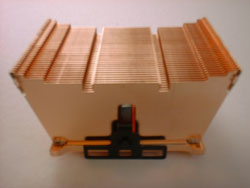
The SK-7 is an all copper 485 gram heatsink. The first thing notable about this heatsink is its weight. It is much heavier than the stock aluminum heatsink that comes with retail AMD processors. It comes securely packaged in a small cardboard box with the Thermalright logo printed on the top. Inside the box was a syringe of thermal paste, foam pads, and 8 wire fan clips. These clips connect to the base of the heatsink, and allow four fan sizes between 70mm to 80mm. The base of the heatsink is polished to a mirror finish, and the heatsink attaches securely to the motherboard with the use of a three pronged heat sink clip. The heat sink does not come packaged with a fan.
The SLK-800
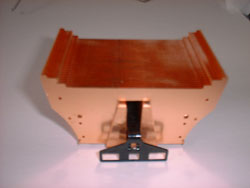
The SLK-800 is an all copper 505 gram heatsink. It is more expensive than the SK-7, and the one I received did not come packaged with any thermal compound. It too was packaged securely in a small cardboard box. It came with foam pads, and two wire fan clips. The clips packaged width the SLK-800 fit into holes made in the side of the heatsink, and by changing which holes they
are placed in allow fan sizes from 60mm to 80mm. The SLK-800 uses a three pronged clip to attach itself to the heatsink, and during testing appeared to be extremely secure. Even with the heavy weight of the heatsink, I never felt the heatsink was insecure when moving my computer. This heatsink is also sold without a fan.
Differences Between the SK-7 and the SLK-800
Top
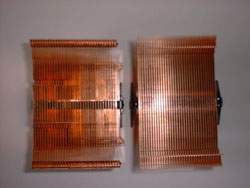
(SK-7 and SLK-800)
From the top these two heatsinks do not differ much from each other. Both use thin copper fins soldered to the solid copper base. The SK-7, on the left, is actually 9mm wider than the LK-800.
Bottom
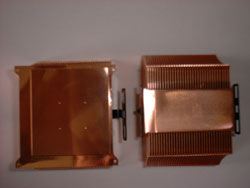
(SK-7 and SLK-800)
When viewed from the bottom the difference between these two heatsinks becomes apparent. The SK-7 has a much larger, square base. The SLK-800 has a smaller rectangular base that does not restrict airflow. Both are polished to a mirror finish.
Side
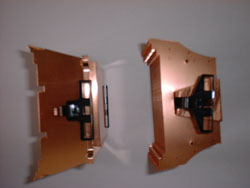
(SK-7 and SLK-800)
The sides of the two heatsinks do not show much design differences. There are two notches in the fins of the SK-7 that are not present on the SLK-800. Both have steps on the edges to hold onto different size fans. On the side of the SLK-800 there are five sets of holes for the wire fan clips. The SK-7 has holes on the bottom of the heatsink for its four sets of fan clips.
Fins
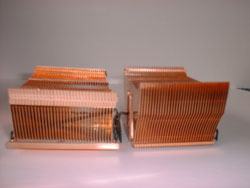
(SK-7 and SLK-800)
The fins of both heatsinks are made from thin copper and welded to the base of the heatsink. The SK-7’s fins are folded over on the edge which helps them from bending. The SLK-800 has nothing to protect this, and without careful handling can be damaged. This picture also shows how the SLK-800 is taller and thinner than the SK-7.
Test Configuration
Fans
The test of these two heatsinks involved six different airflow configurations using two fans, a Zalman ZM-F1 and a Vantec Tornado. The Zalman fan is a standard 80mm by 25mm sized fan and comes with a resistor, which allows operating the fan at two different speeds. Normal operation at 12 volts pushes 39 Cubic Feet of air per Minute (CF/M) while being 34.4 decibels loud. With the resistor in place the Zalman pushes only 20.6 CF/M, but at a quiet 20 decibels. The second fan used is a Vantec Tornado. This is a monster 80mm x 38mm fan that pushes 84 CF/M at a loud 55 decibels. To make the test more interesting I tested this fans both pushing air down into the heatsinks, and pulling air out of them.
| Fan | Airflow (CF/M) | Decibels |
| Zalman ZM-F1 @ 5.5 volts |
20.6
|
20
|
| Zalman ZM-F1 @ 12 volts |
39
|
34.4
|
| Vantec Tornado |
84
|
55
|
(specs from manufacturer)
System
The heatsinks are attached to the CPU using Arctic Silver 3 heat compound, using the detailed instructions on the companies website. The CPU used is an AMD Athlon XP 2100+ Palamino, one of the last Athlons manufactured on the .18 micron process. This also makes it one of the hottest running non-overclocked chips. The motherboard the chip is plugged into is an Epox 8RDA NForce2 based motherboard. This motherboard is installed in an Antec 830sx case with four NMB ultra quiet 18 CF/M case fans. Temperature is being read from the motherboard sensors using Motherboard Monitor 5.2.2.0. The temperature is first read after letting the system sit idle for half an hour. Then the Folding@Home client is started, and run for 30 minutes before the second reading. The same F@H work unit was used for all tests.
Results
SLK-800 Results
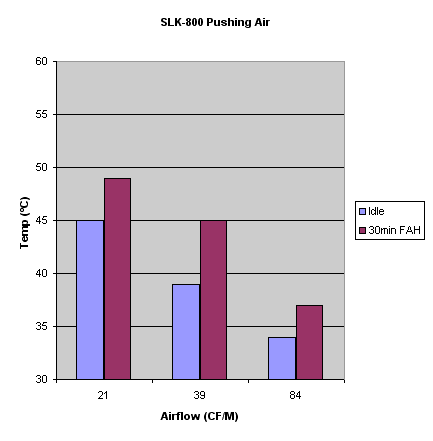
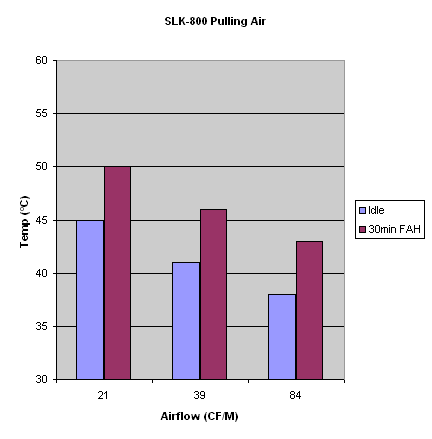
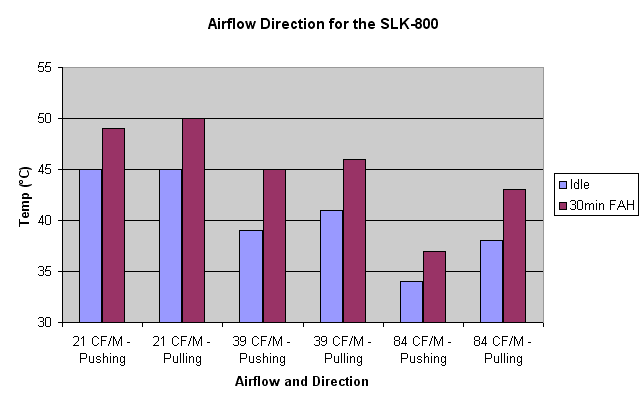
Here we see that the SLK-800 works best with air being pushed down into the fins. Pushing air onto the heatsink resulted in equal or lower temperatures than pulling air through the fins. As he airflow increased, so did the cooling. The best scores were achieved by the Vantec Tornado pushing air onto the heatsink.
SK-7 Results
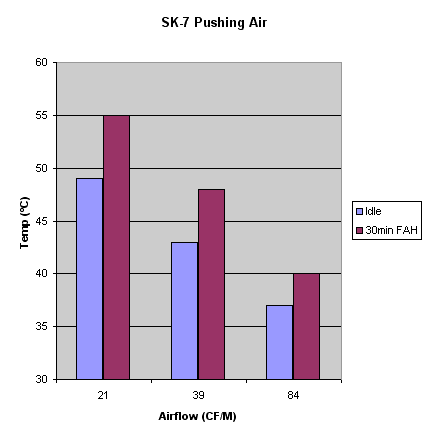
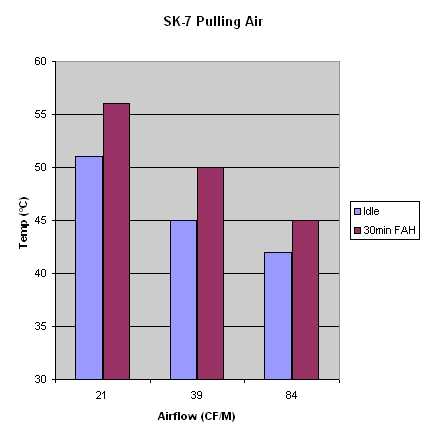
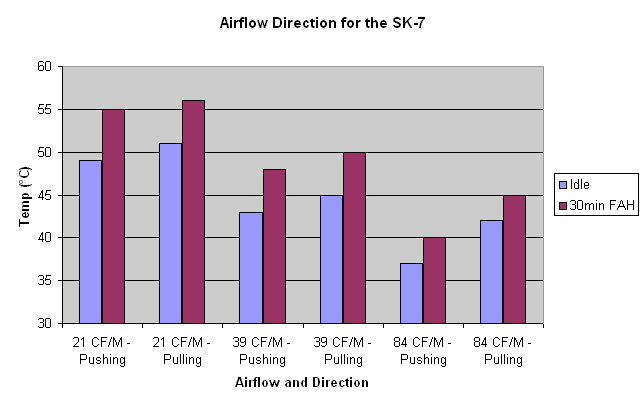
Similar effects to the SLK-800 were resulted with the SK-7. The lowest temperatures were produced by having air pushed into the heatsink. The higher airflow fans also produced lower temperatures.
Comparison between SLK-800 and SK-7
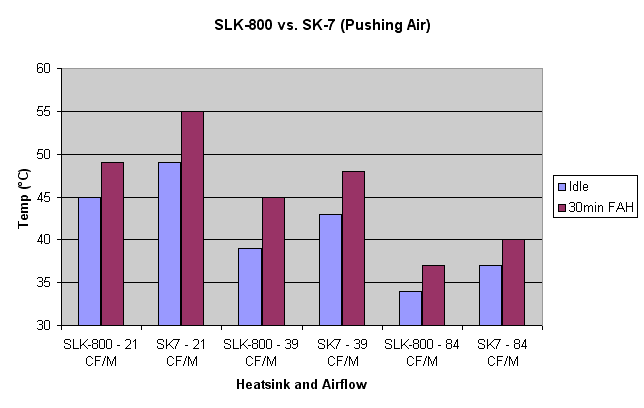
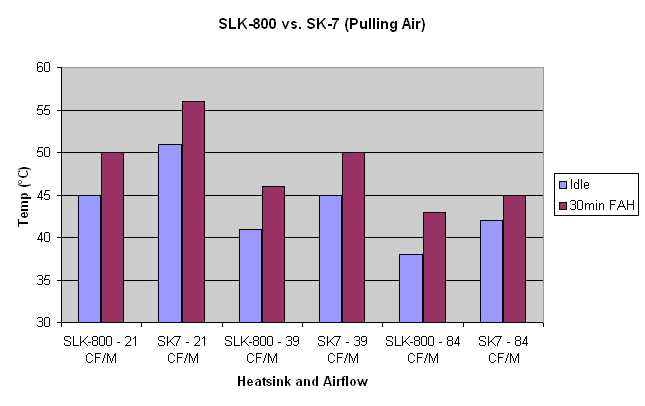
In the comparison graphs we see that the SLK-800 outperforms the SK-7 in every test. The widest margins are seen with the lower airflow fans, with the delta between the two heatsinks reaching as high as 6 degrees Celsius. Even though the SLK-800 and SK-7 are nearly identical on paper, the SLK-800 has a better design that provides a cooler CPU at any airflow.
Summary of
Results
|
| Heatsink | Direction | Airflow (CF/M) | Idle | 30min F@H |
| SLK-800 | Pushing | 21 | 45 | 49 |
| SLK-800 | Pushing | 39 | 39 | 45 |
| SLK-800 | Pushing | 84 | 34 | 37 |
| SK-7 | Pushing | 21 | 49 | 55 |
| SK-7 | Pushing | 39 | 43 | 48 |
| SK-7 | Pushing | 84 | 37 | 40 |